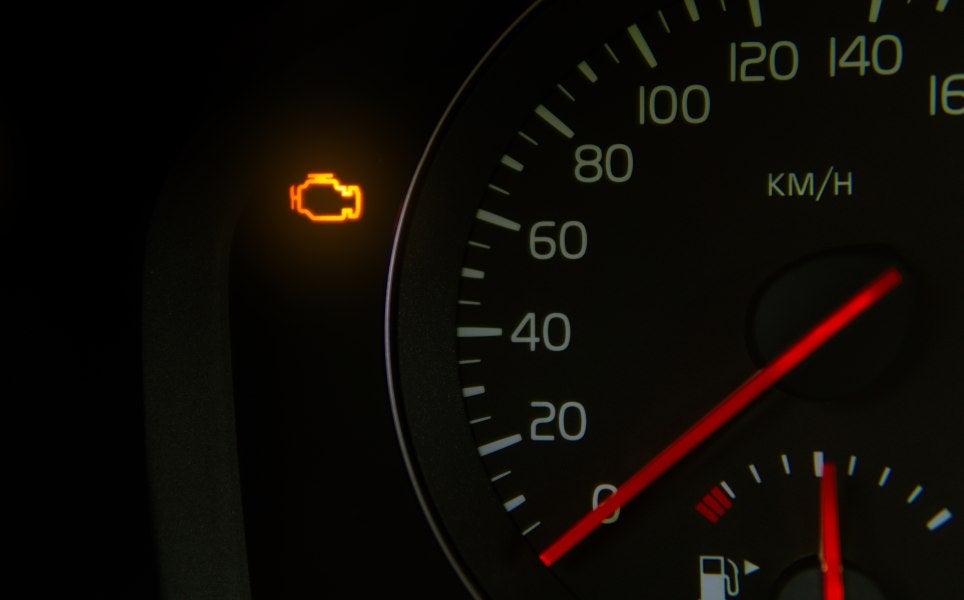Understanding the Check Engine Light
Introduction
The check engine light, a familiar yet often misunderstood dashboard alert, plays an important role in vehicle diagnostics. Understanding this light is key to maintaining vehicle health and safety, especially for drivers in Canada, where unique environmental conditions prevail. In this article, we’ll try to de-mystify the check engine light and shed some light on what actions you need to take when it comes on.
What Causes the Check Engine Light to Come On?
The illumination of the check engine light can be attributed to various issues, ranging from minor to severe:
- Oxygen Sensor Failure – Your oxygen sensor measures the amount of unburned oxygen in your vehicle’s exhaust system. This indicates how thoroughly the air to fuel mixture is burned during the combustion process. The failure of the oxygen sensor can affect fuel efficiency and emissions.
- A Loose or Faulty Gas Cap – Your gas cap is part of a sealed evaporative emissions system that recirculates gasoline vapors from your car tank and keeps them from escaping into the air. If your gas cap is faulty or if it is loose, this can lead to fuel evaporation.
- Catalytic Converter Problems – The catalytic converter helps to protect our environment by superheating hydrocarbons into compounds like carbon dioxide and water vapor. Problems with this device can impact your car’s performance.
- Mass Air Flow Sensor Issues – The mass air flow sensor measures the amount of air entering the engine to determine how much fuel is needed to run your engine properly. These sensors are sensitive to oil, dirt, and water vapor, and any contamination on them can trigger a light.
- Spark Plugs/Ignition Coil Problems – Your spark plugs ignite the air fuel mixture in the combustion chamber of your vehicle, but if the timing of that spark isn’t perfect, you will get a misfire.
- Exhaust Gas Recirculation Valve (EGR) Issues – The EGR valve is a key component in your vehicle’s engine that plays a vital role in reducing emissions and improving engine efficiency.
- Transmission Issues – A serious transmission issue can be very costly to repair. In most cases, this will require immediate action.
Check Engine Light Variations
The check engine light can appear in different forms:
- Steady Light – This suggests a less urgent issue.
- Flashing Light – This indicates a severe problem, often requiring immediate action.
Reading Car Codes
When the light comes on, it’s accompanied by a diagnostic trouble code. These codes, accessible via an onboard diagnostic (OBD) scanner or a smartphone app, provide specific insights into the issue. Codes starting with P0 are generic powertrain related, while P1 codes are manufacturer specific.
Professional Diagnostics and Repairs
While some issues can be addressed through DIY fixes, like tightening a gas cap or replacing spark plugs, complex problems require professional expertise. A trained mechanic can offer accurate diagnostics and repairs, and check for warranty or recall issues, potentially saving on repair costs.
Preventative Measures
Regular maintenance is vital for avoiding check engine light issues:
- Scheduled Maintenance – Following the vehicle’s maintenance schedule is the best way to stay ahead of problem issues.
- Seasonal Maintenance– Preparing your vehicle for Canada’s weather conditions, including winter service checks, helps to avoid issues associated with cold weather.
- Avoiding Common Mistakes – Ignoring minor issues or making mistakes such as miss-fueling your vehicle can cause your engine light to come on.
Legal and Environmental Implications
In many Canadian provinces, vehicles with an active check engine light cannot pass emissions testing, leading to legal and financial repercussions. In addition, ignoring such issues could contribute to environmental pollution.
Conclusion
The check engine light is an essential alert system, signaling potential issues with a vehicle. Understanding its causes, knowing how to read diagnostic codes, and addressing problems promptly are vital for vehicle longevity, especially in Canada’s challenging environment. Regular maintenance and a proactive approach to vehicle care can prevent major repairs, so that your vehicle can remain reliable, efficient, and environmentally compliant.
Who To Call?
For over 25 years, Tire Pirates in Calgary has provided top-quality tire and auto repair services at two locations in Calgary: Foothills and Chinook. With a strong emphasis on customer satisfaction, our skilled technicians offer a wide range of services including oil changes, tire installation, brake service, alignments, and many other automotive services including repairs. Our tire catalog covers all driving conditions and vehicle types, including construction, industrial, and agricultural equipment. We focus on delivering quick, efficient service, ensuring customer satisfaction and the best value for your money. Schedule your appointment now!
RECENT POSTS
categories
- Uncategorized
- Air Pressure Tires
- Winter Tires vs. All Season Tires
- All weather tires
- Custom Wheel Options
- Brake Pad Replacement Calgary
- Spare Tire Replacement
- Temporary Spare Tire
- Tire Alignment and Balance
- Getting Tires Fixed
- Do My Tires Need To Be Replaced
- Tire Repair in Calgary
- Transmissions
- Wheels and Tires
- Engine Light
- Car Battery
- Fuel Efficiency


